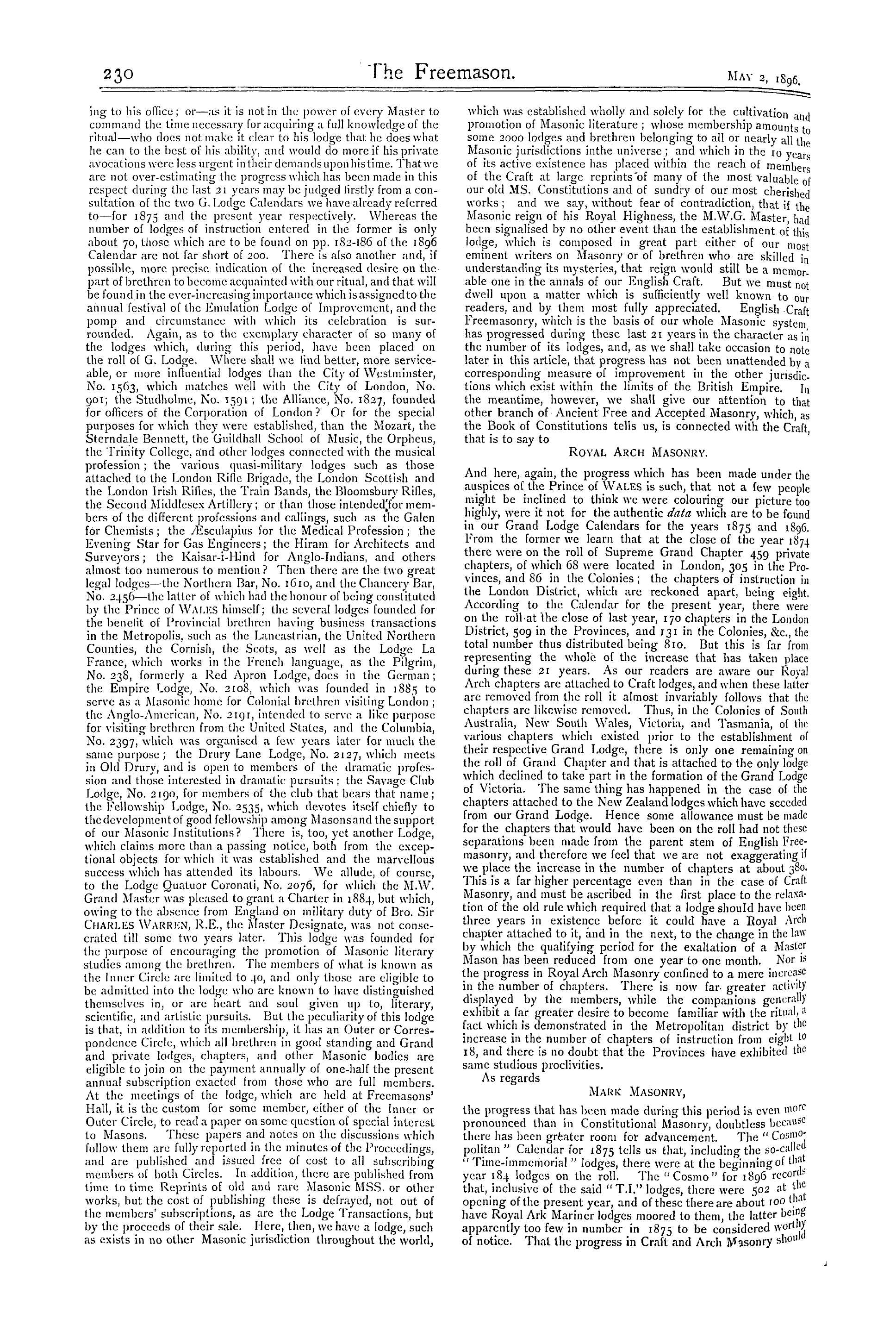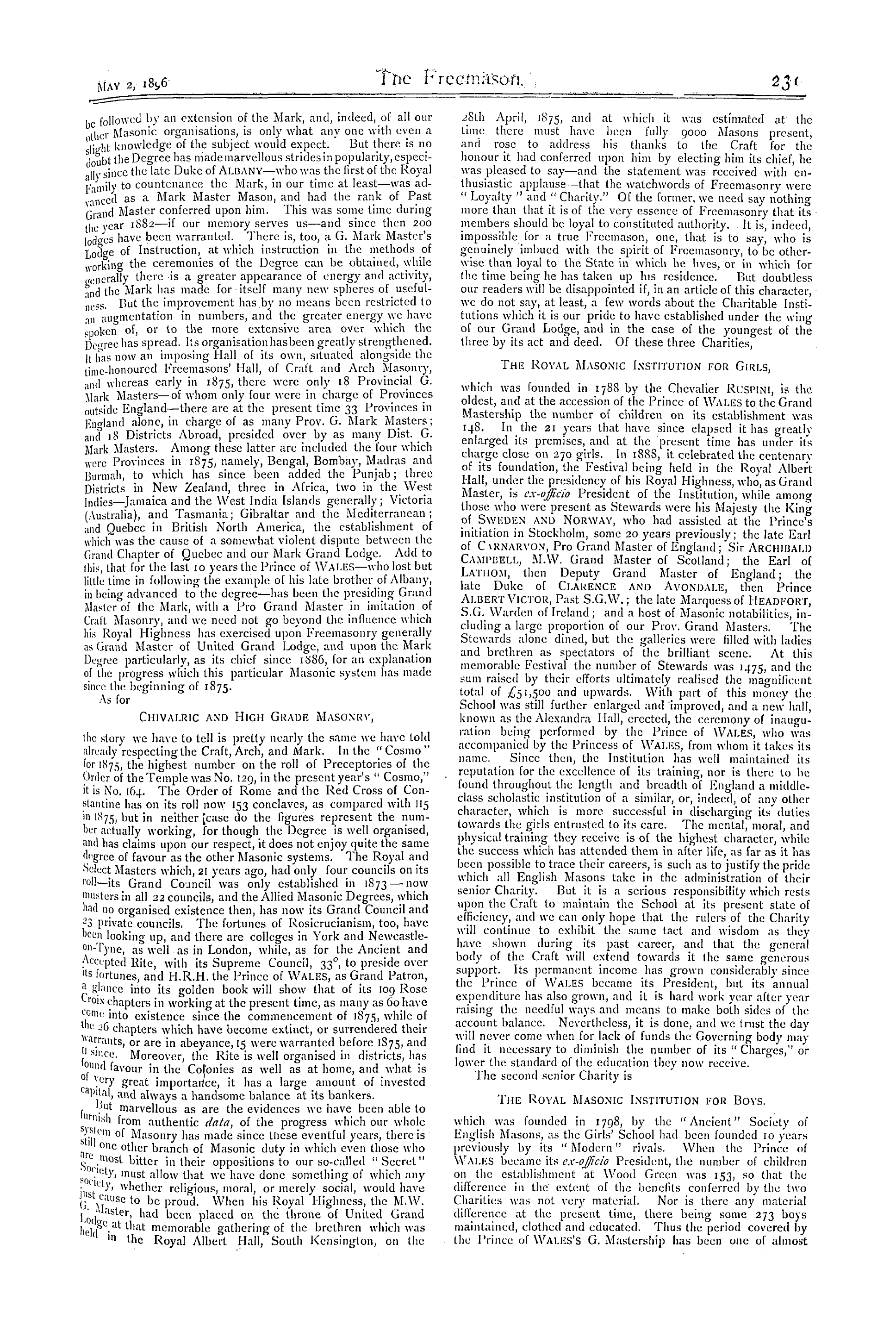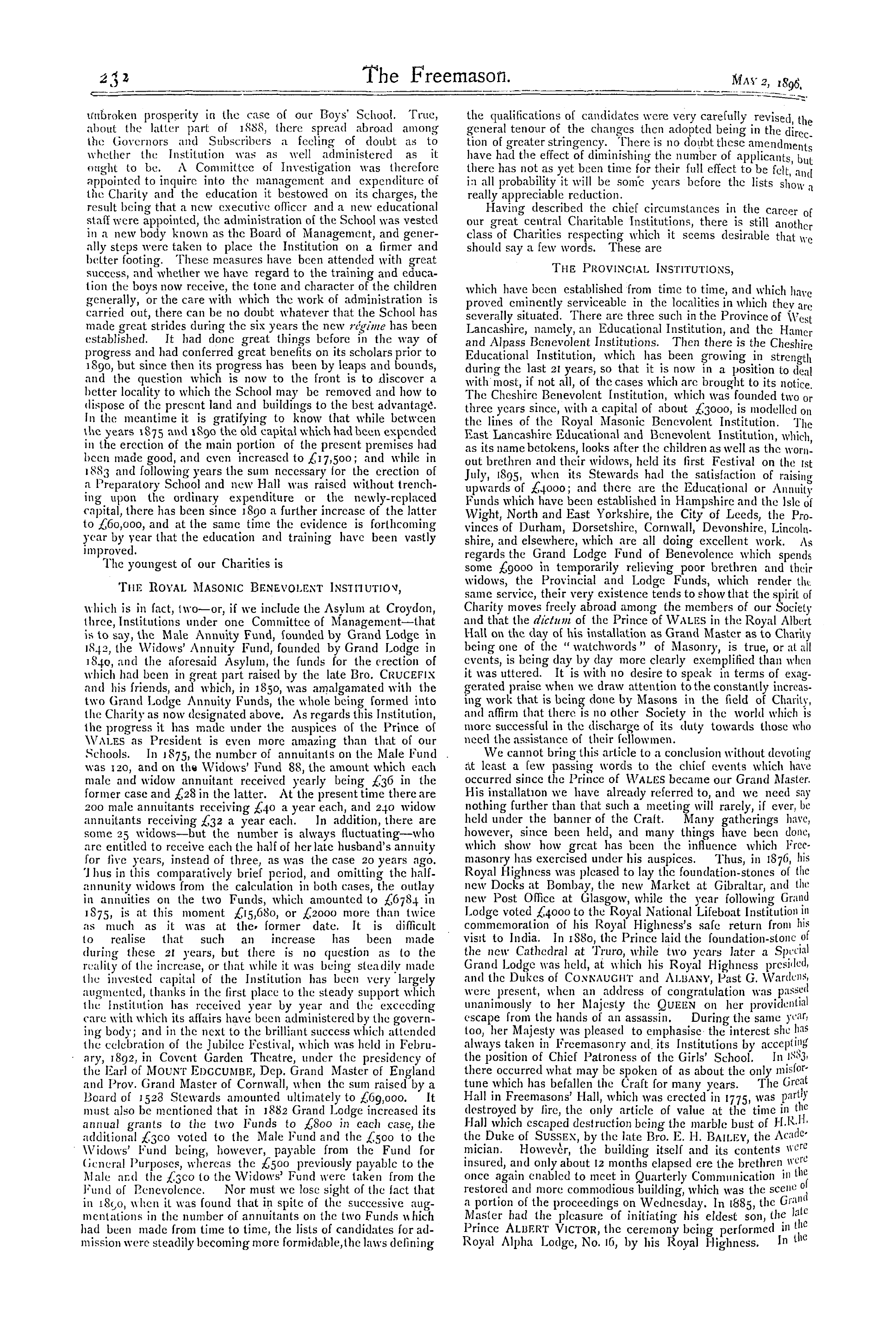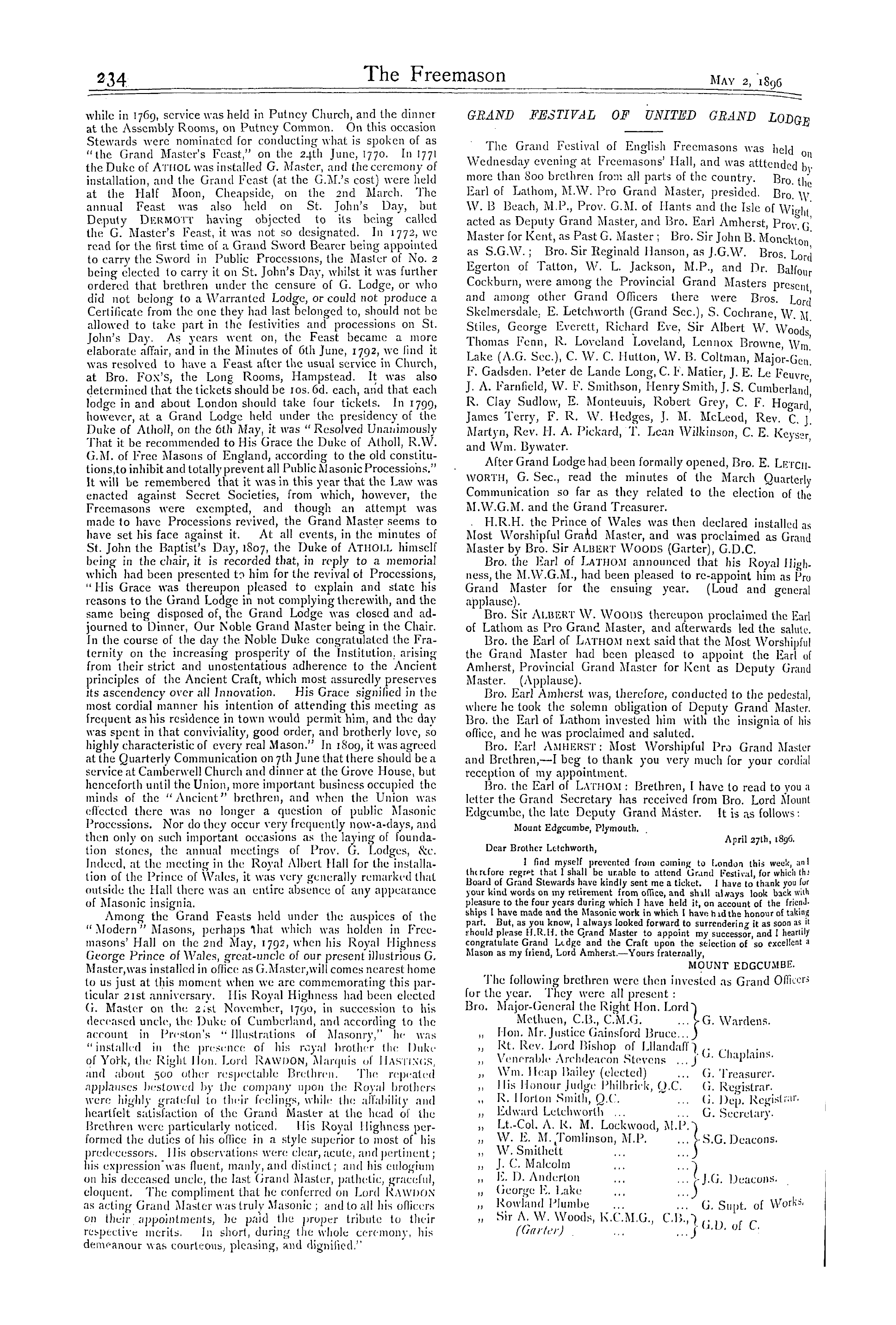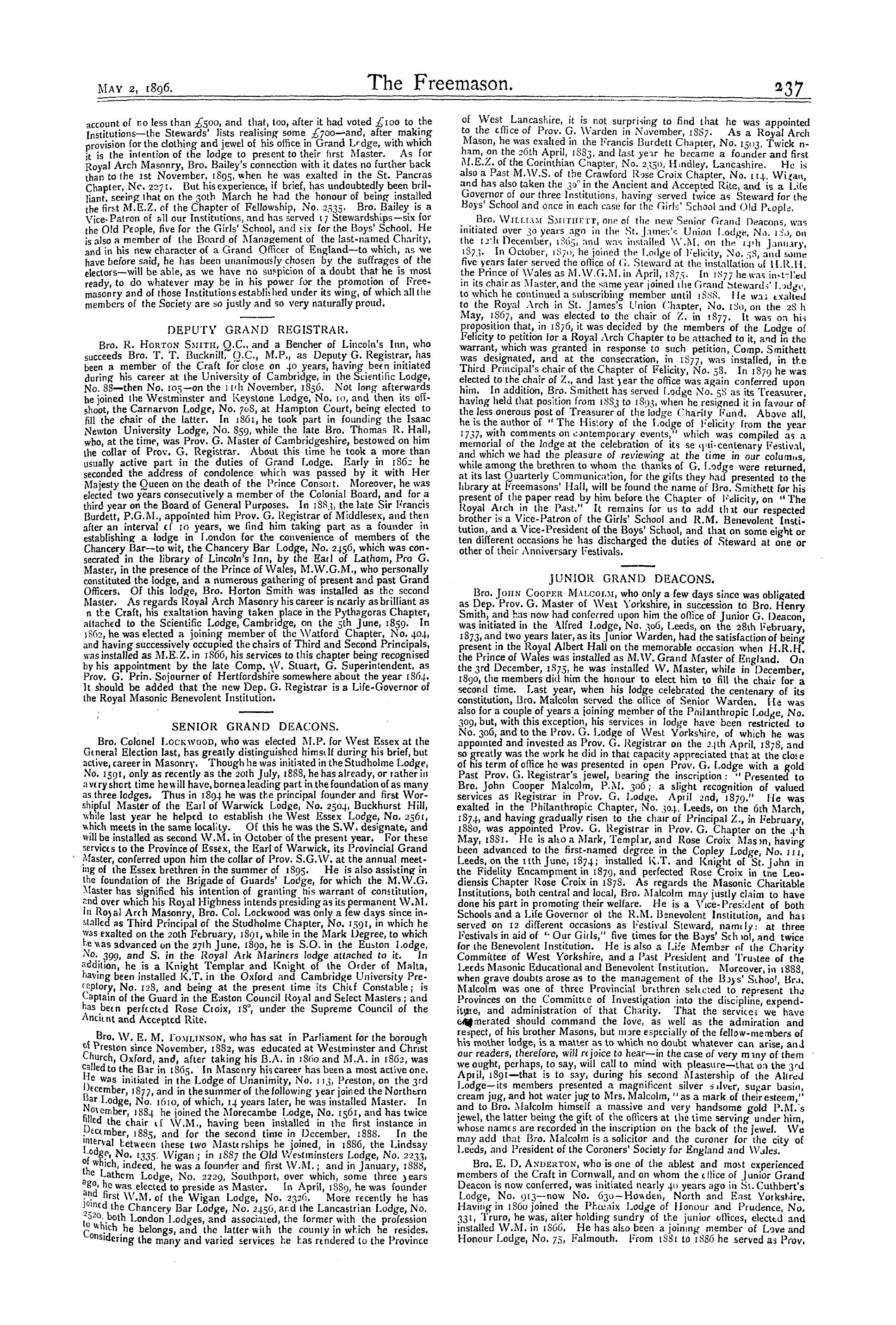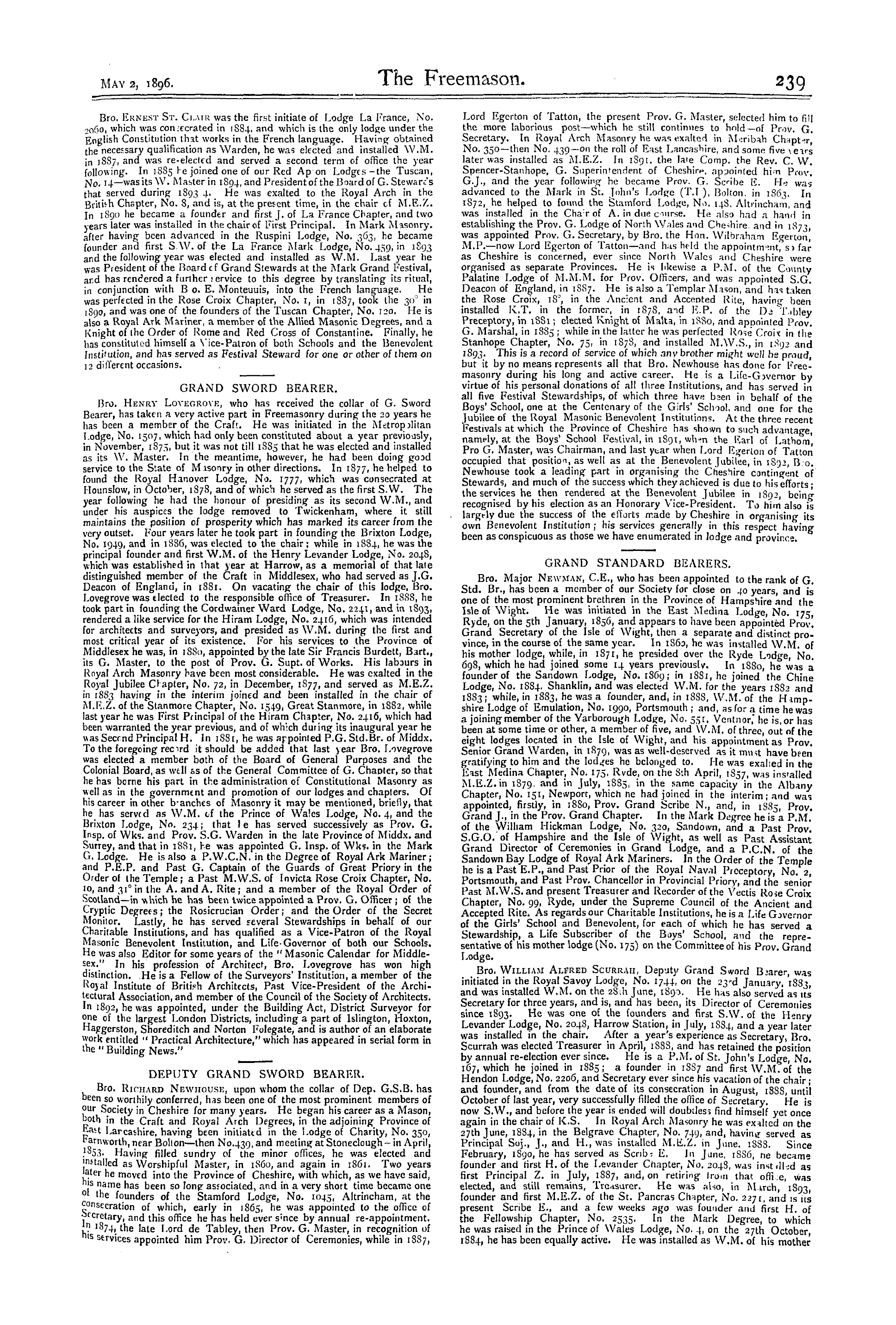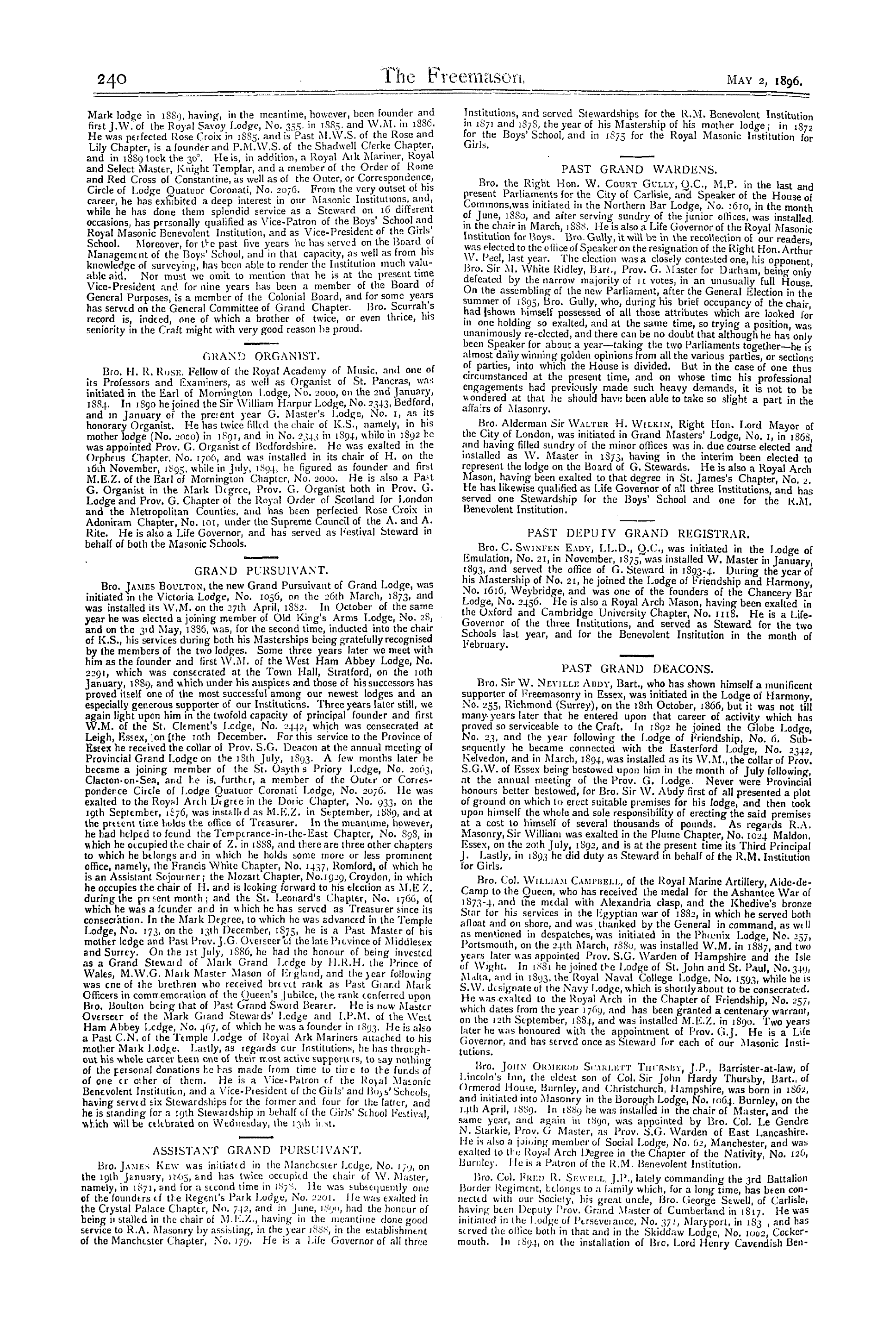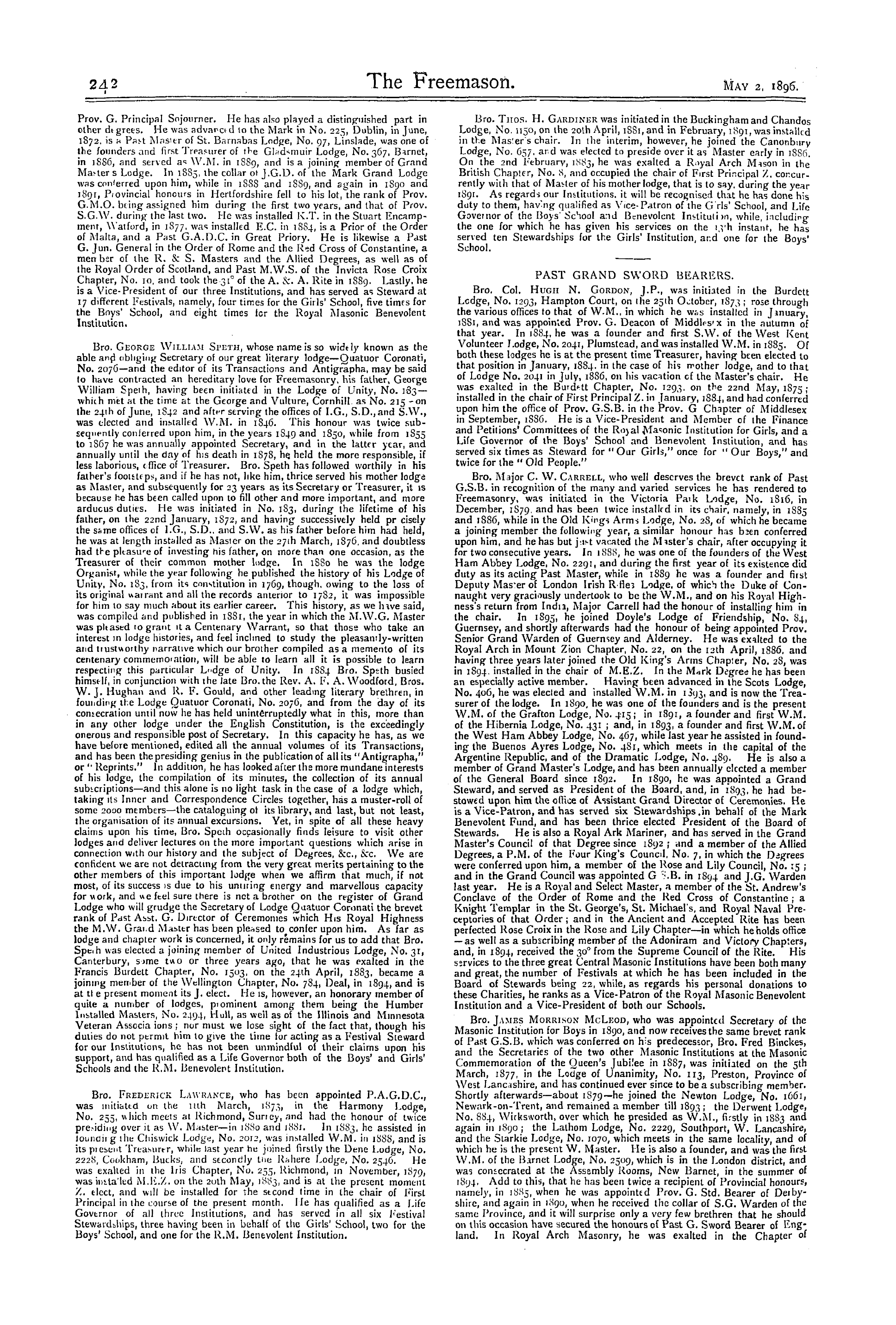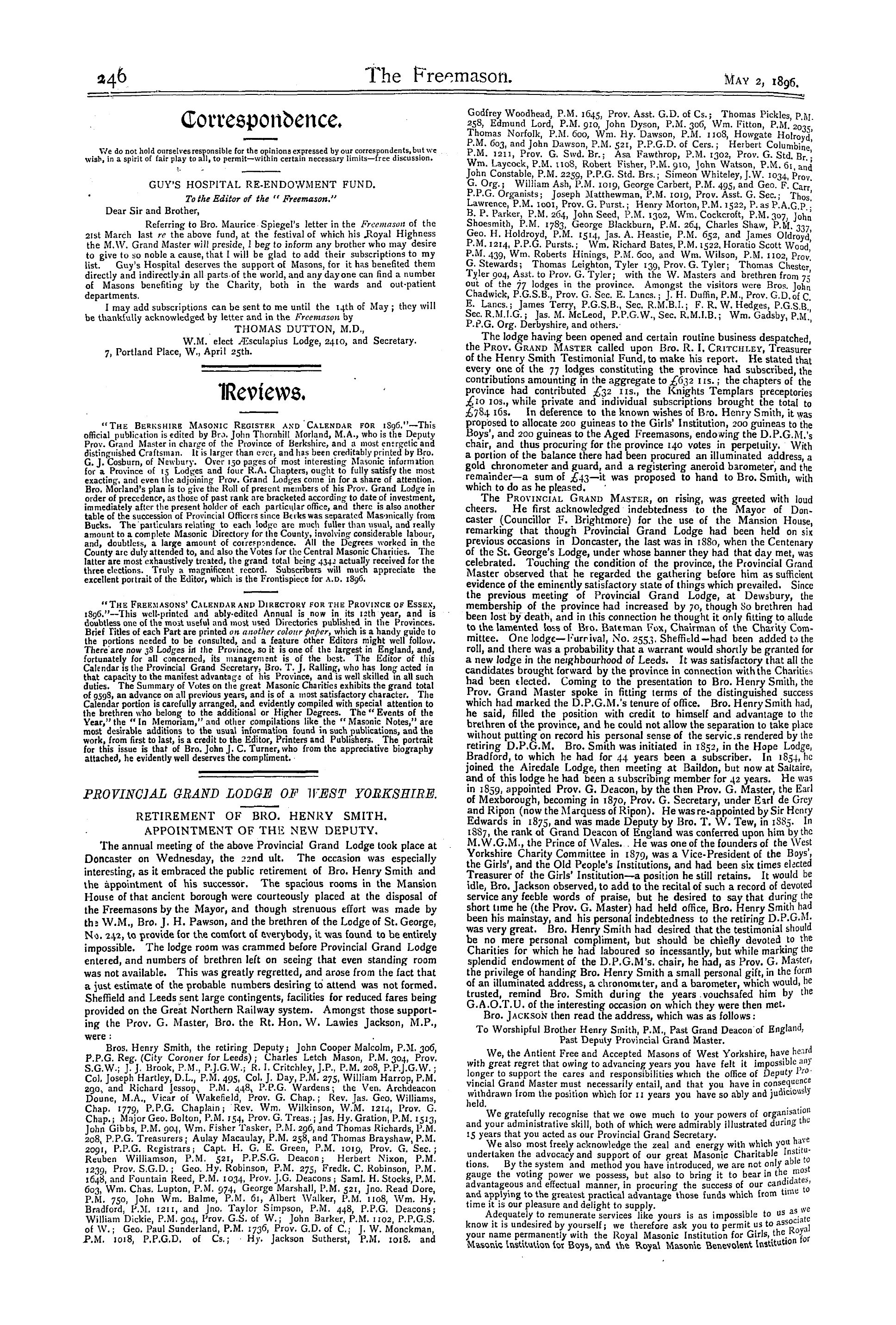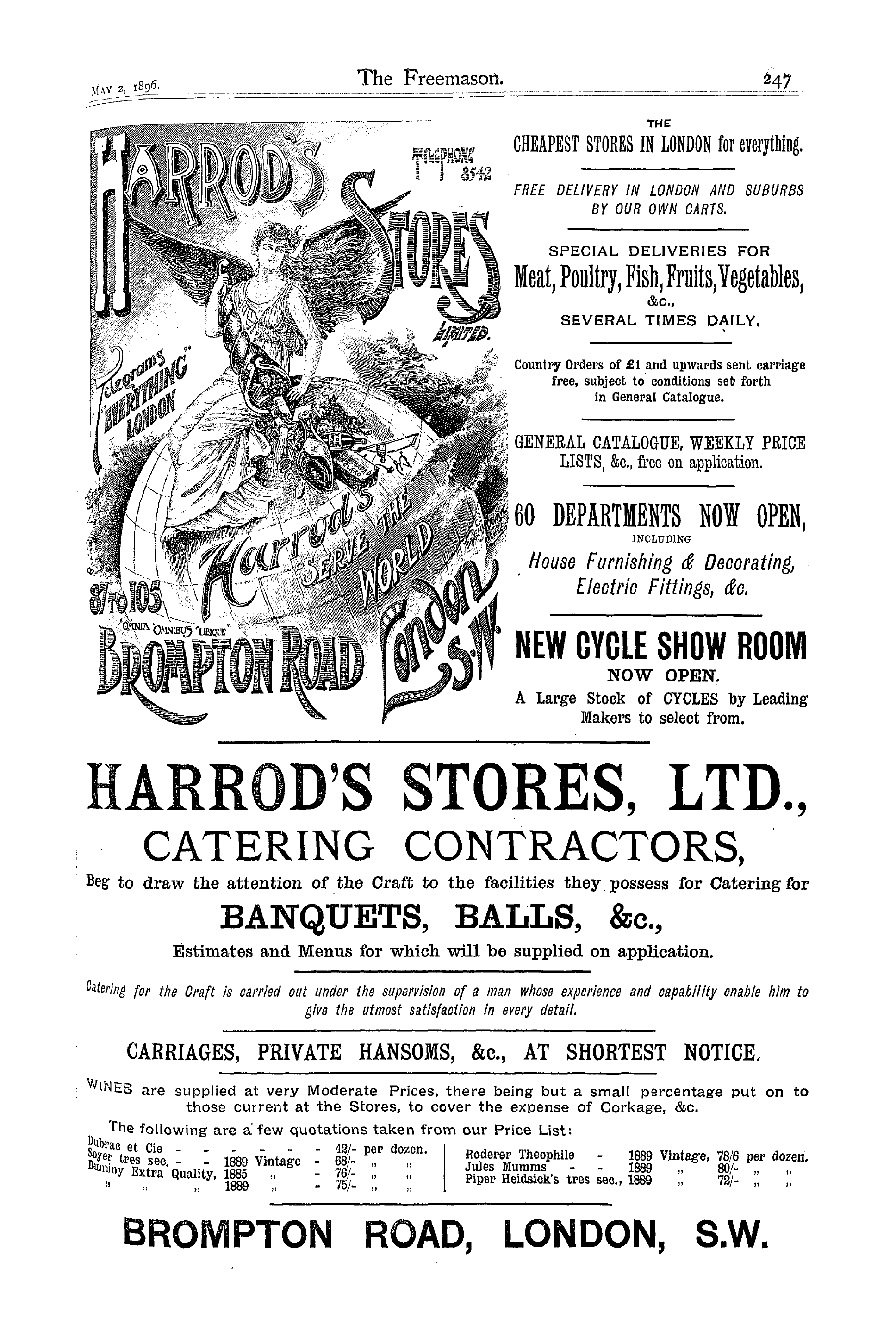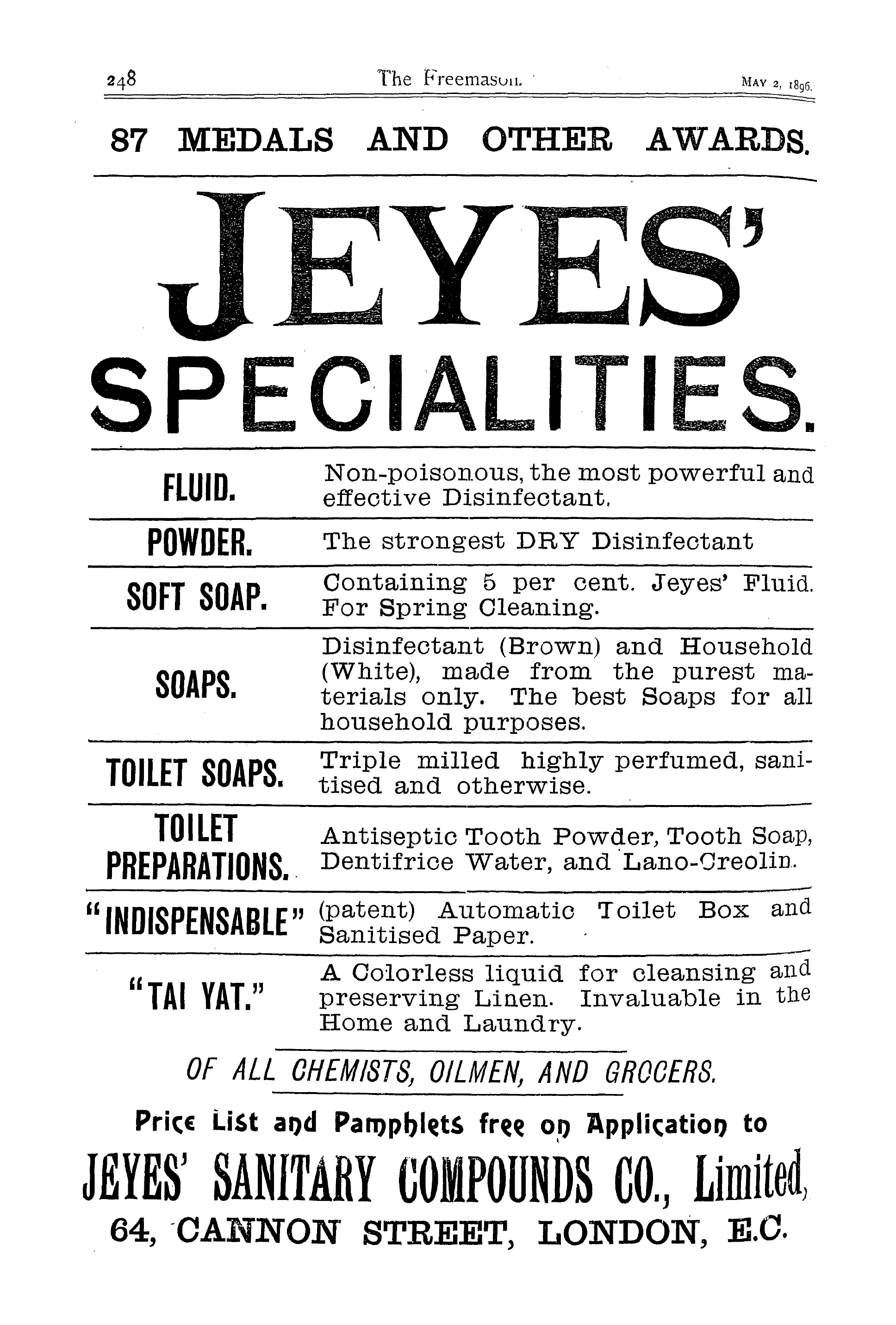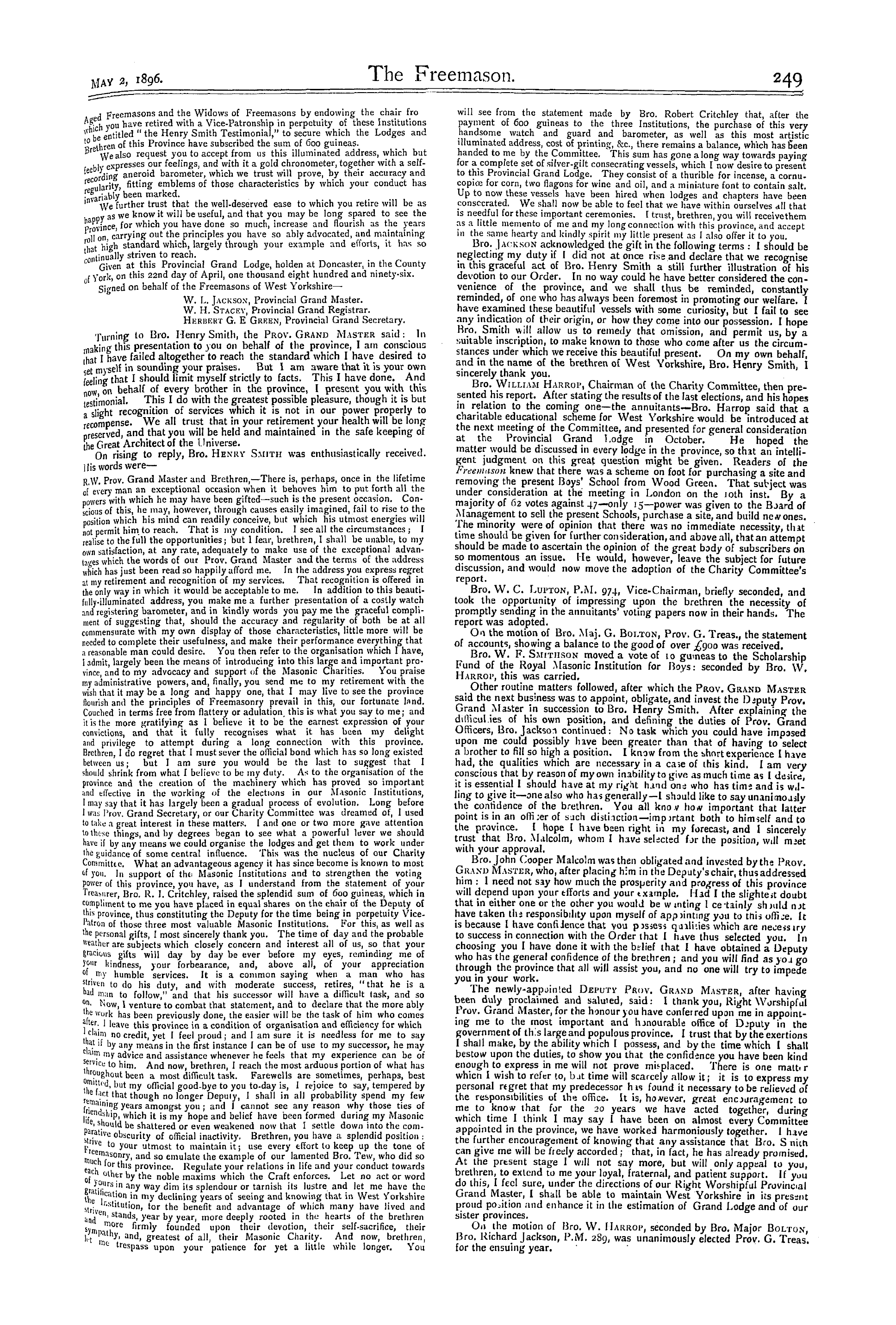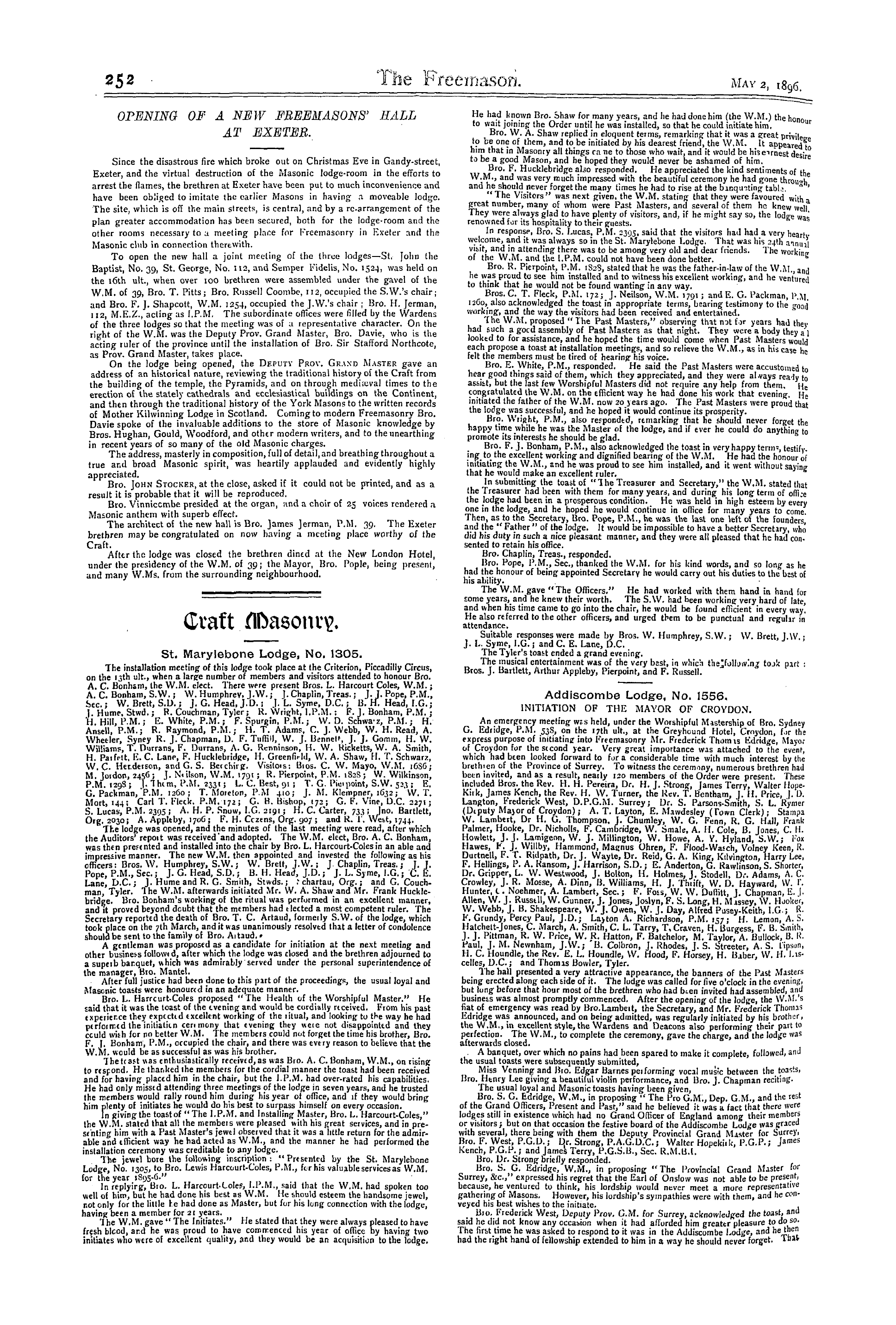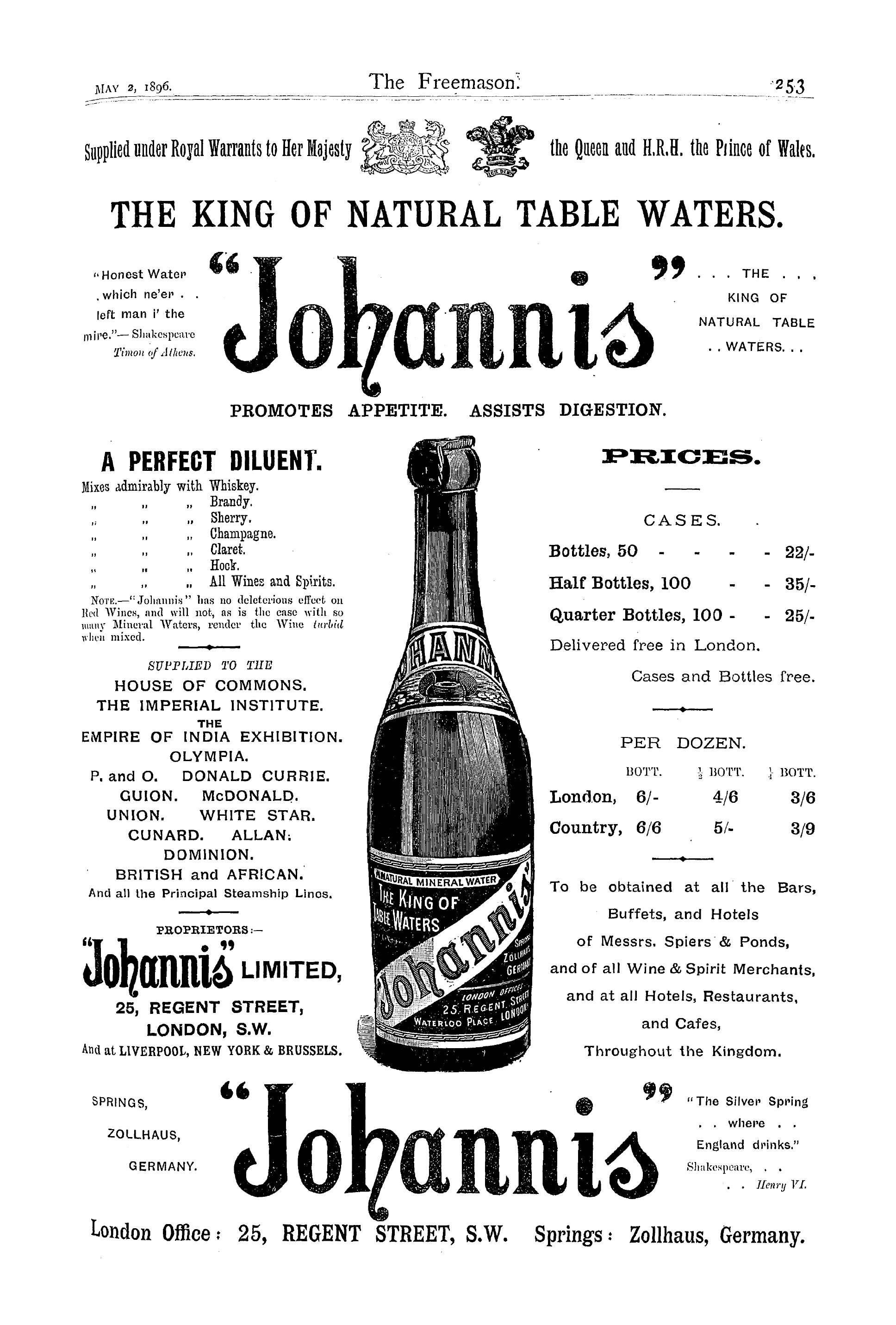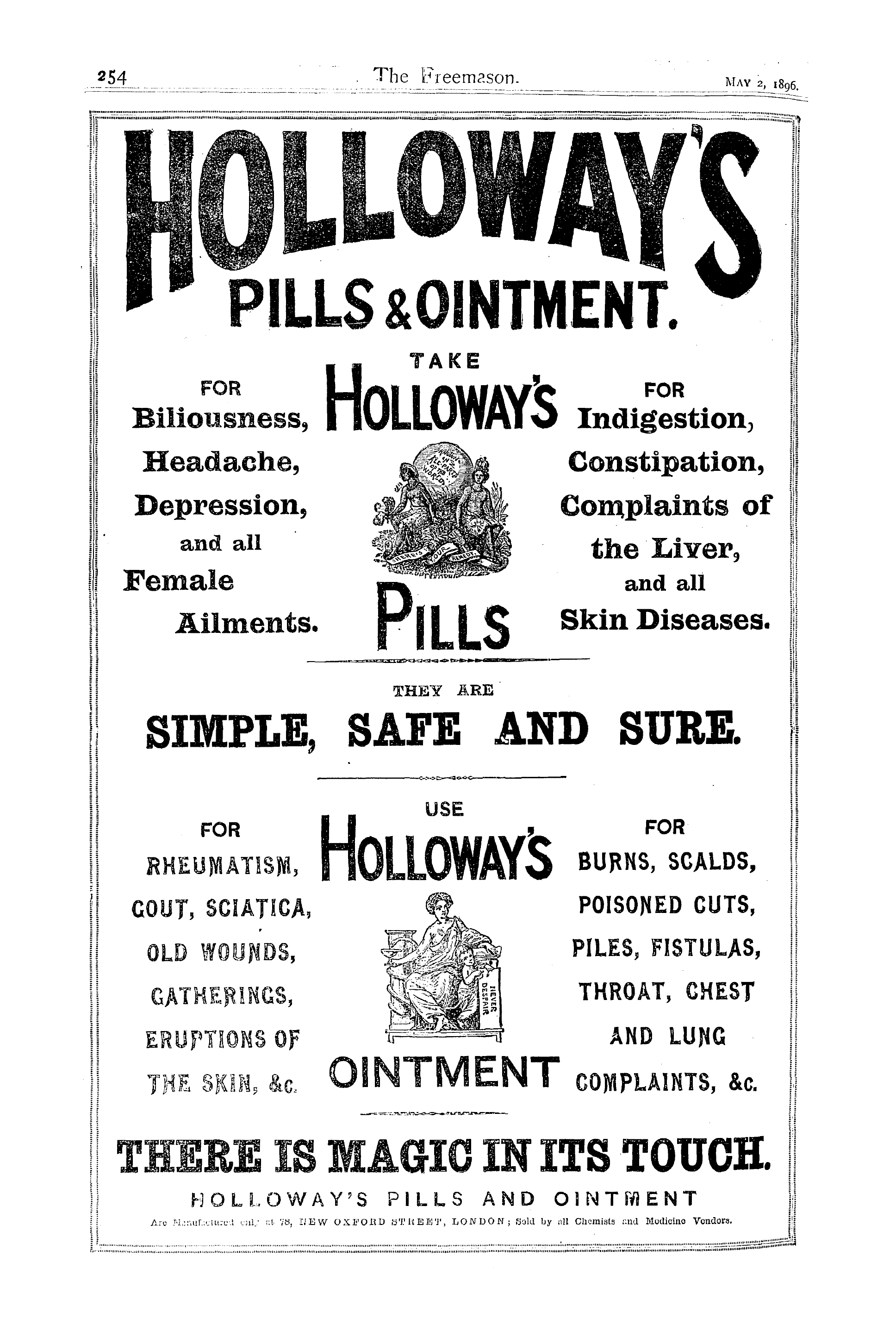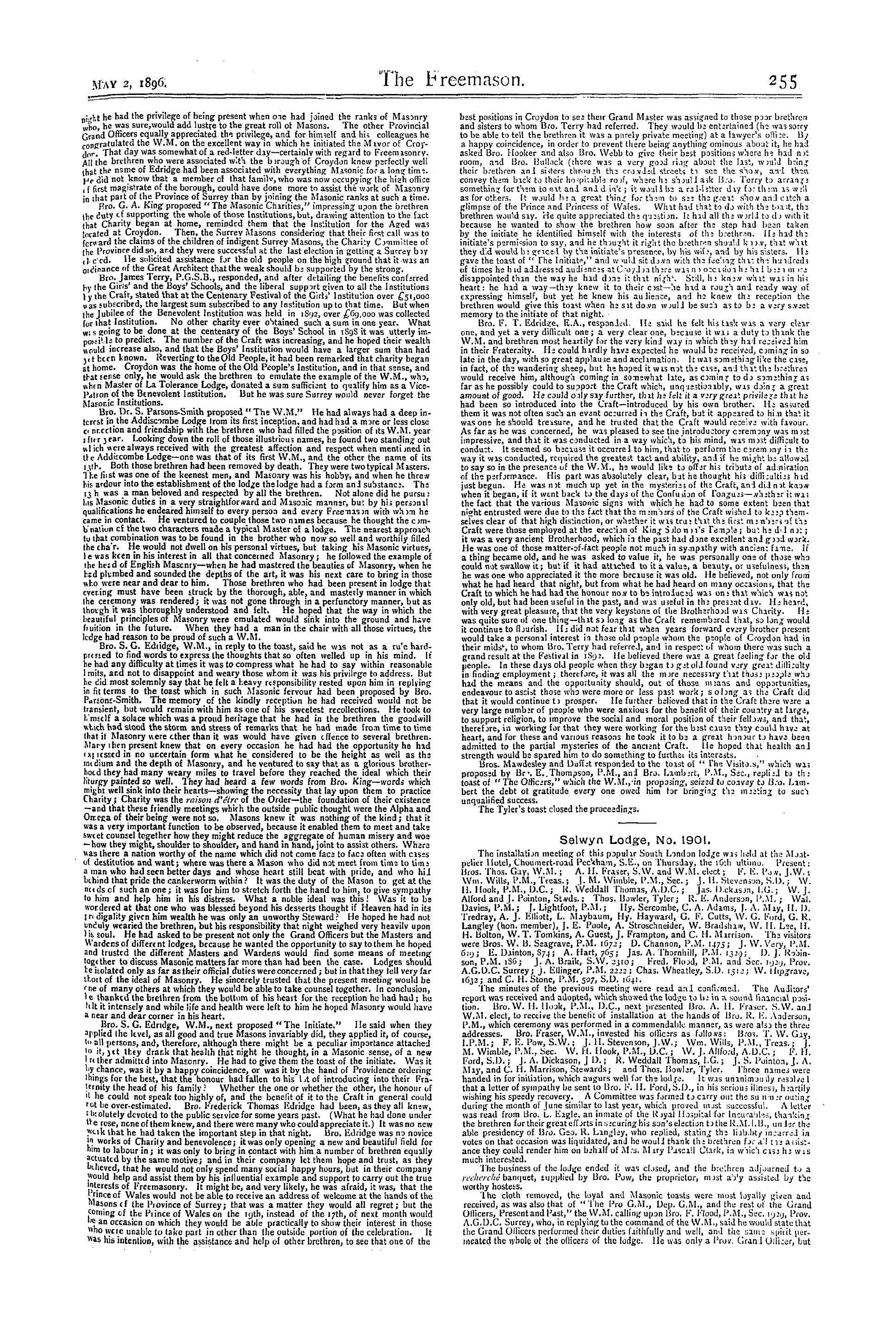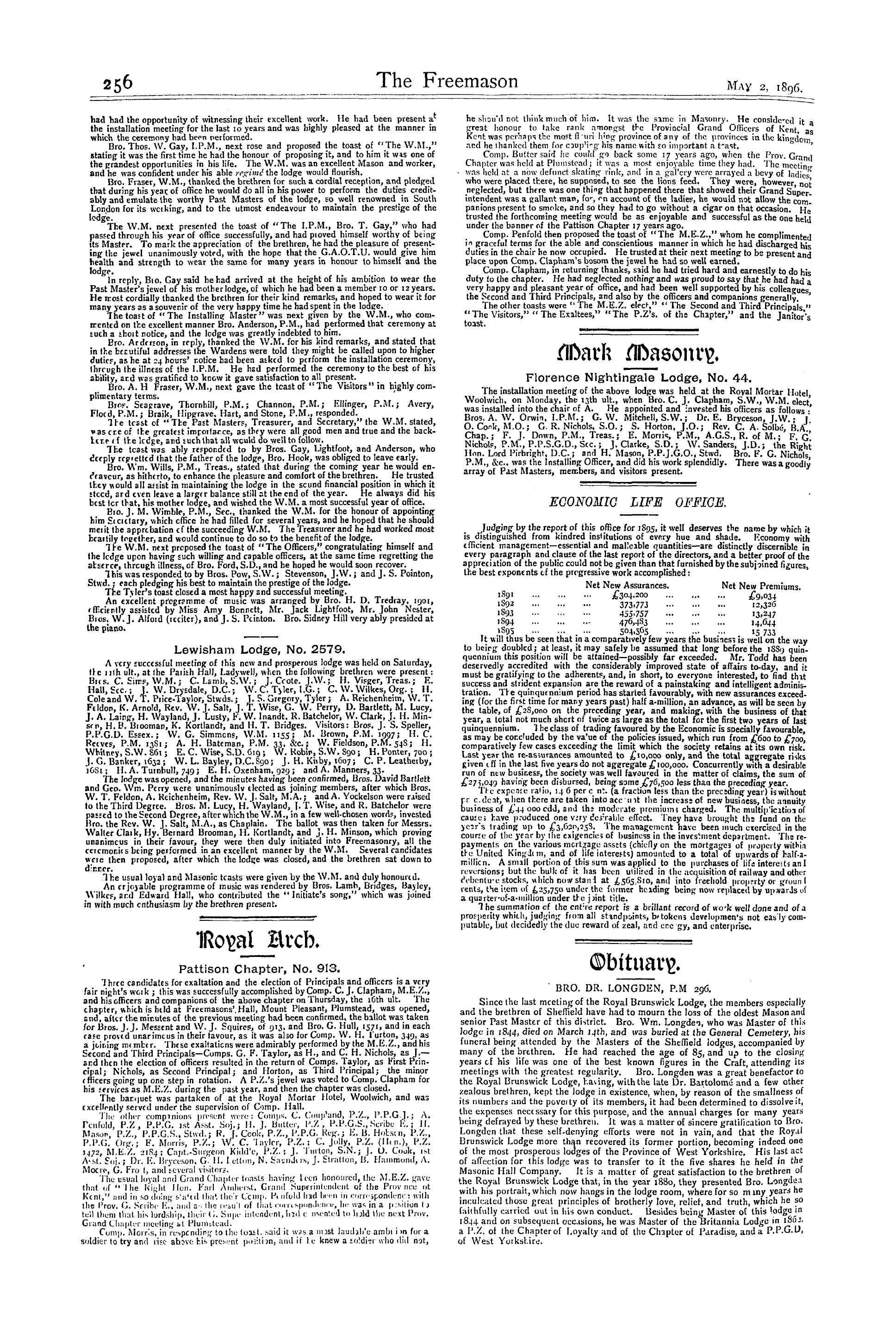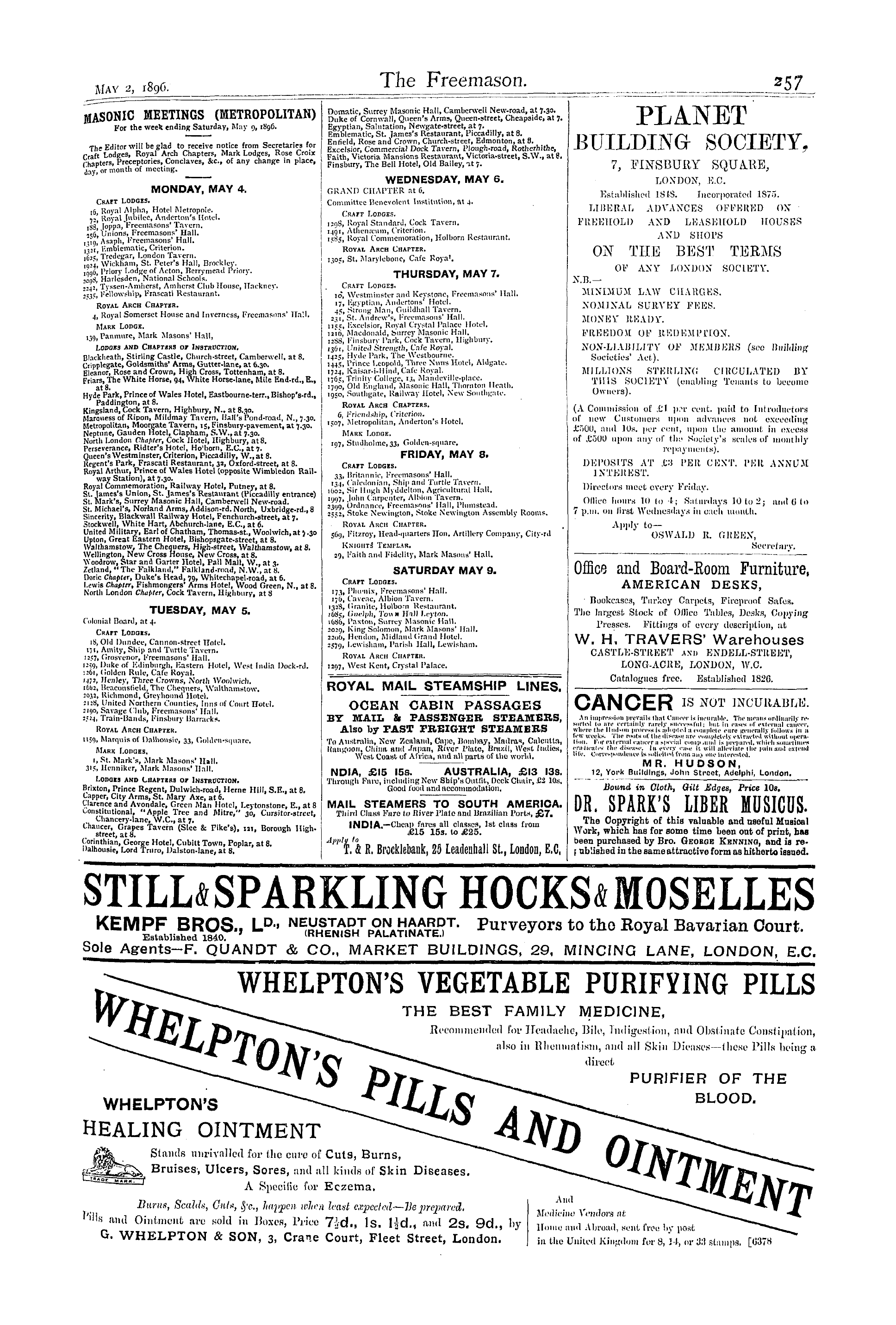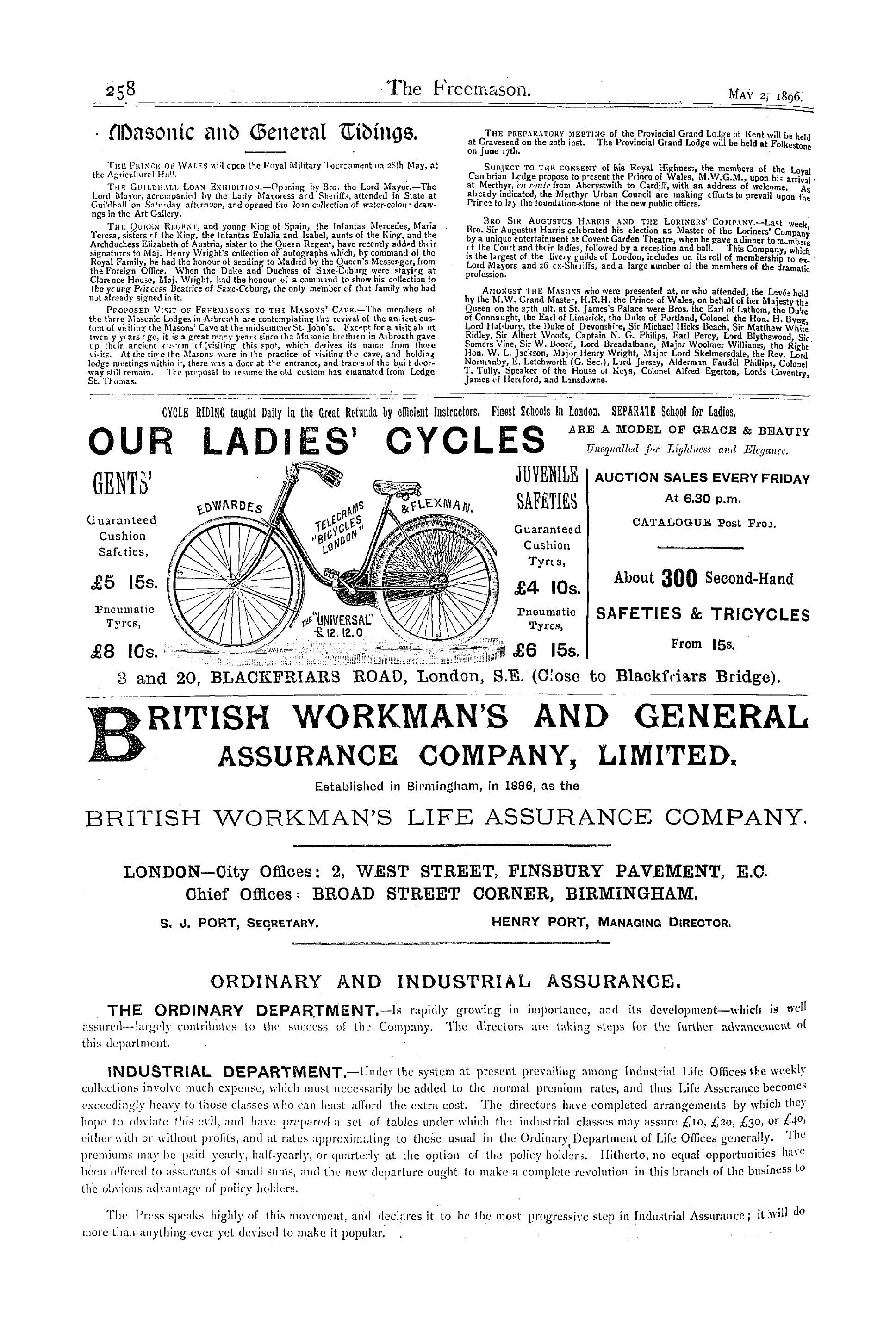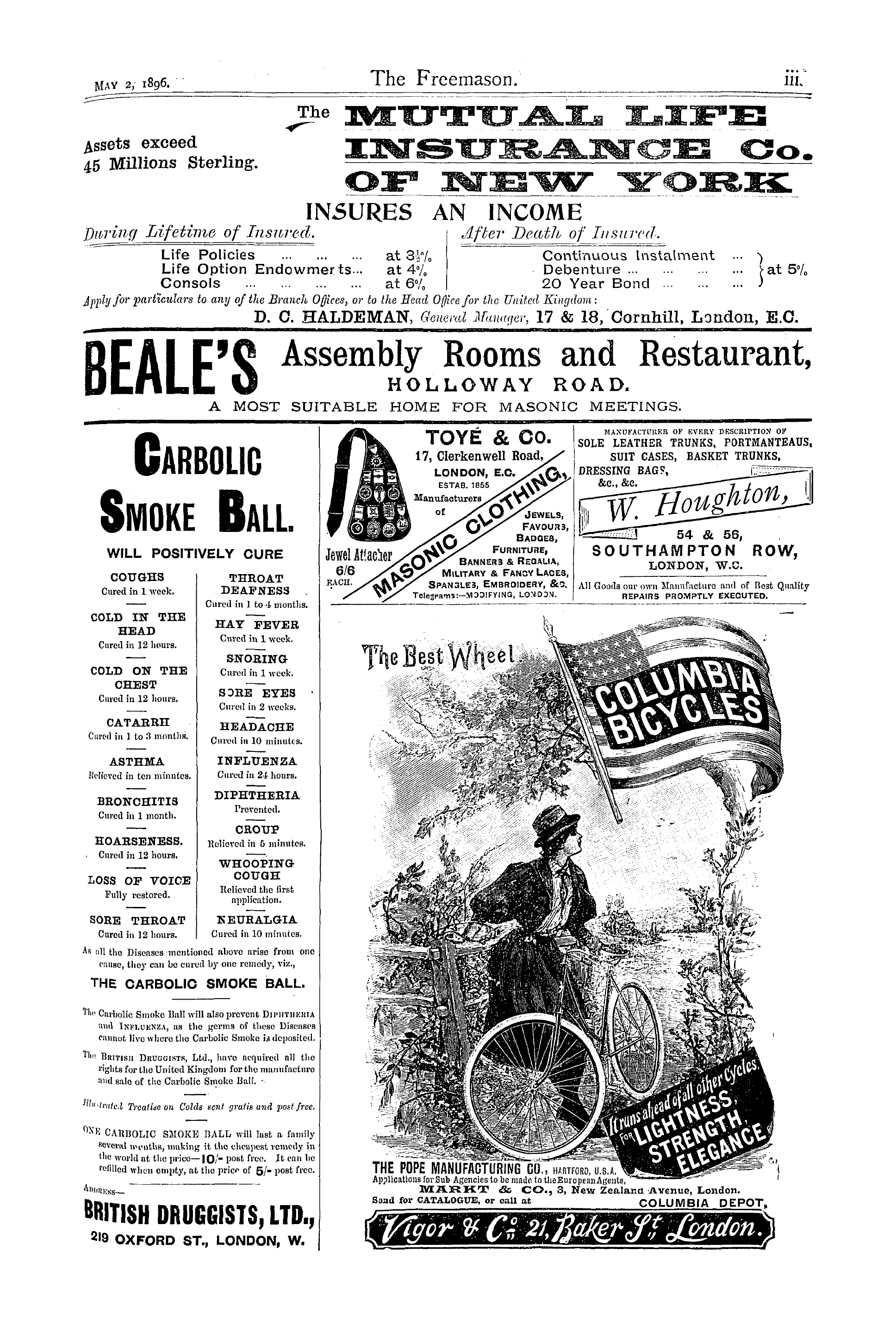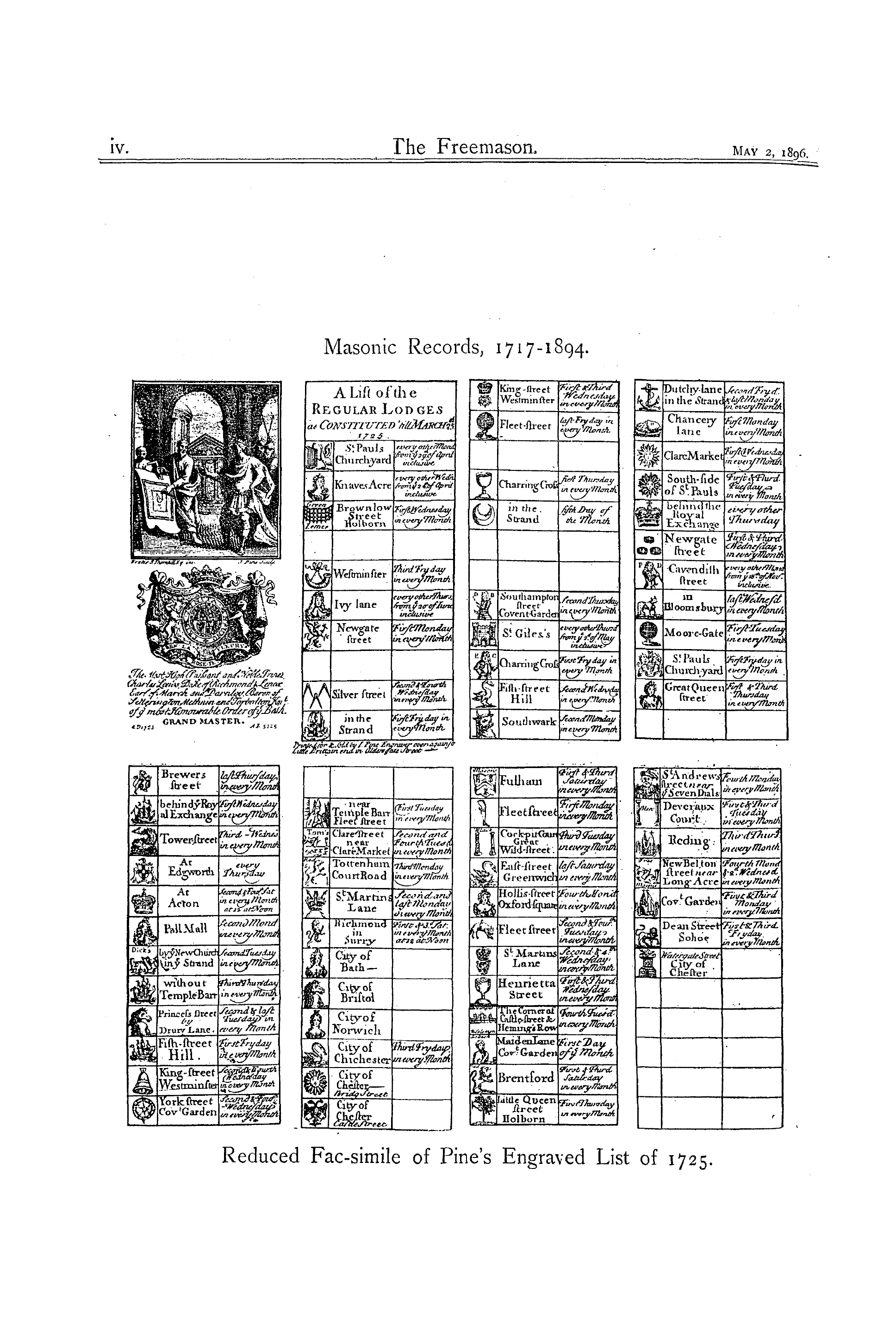-
Articles/Ads
Article ISRAEL LODGE OF INSTRUCTION, No. 205. ← Page 2 of 2 Article ISRAEL LODGE OF INSTRUCTION, No. 205. Page 2 of 2
Note: This text has been automatically extracted via Optical Character Recognition (OCR) software.
Israel Lodge Of Instruction, No. 205.
was purchased by myself for the Grand Lodge some few years ago , and is ° ,, e as " The Grand Lodge Manuscript , No . 2 , " there being an older one in "" ""' collection which { bears the title of "The Grand Lodge Manuscript No . i . " •rk other is of a much more recent period and bears the date 1723 , the same ras the publication of our first printed Book of Constitutions . From an )' " . jc point ot view it is considered the finest in the whole series . It was pre-3 r f J t ; 0 the Grand Lodge only a few months ago by Bro . James S . Haddon ,
ppG . W . cf Somerset , and is known as " The Haddon Manuscript . " Many hours ¦ pht be spent in considering and discussing the various peculiarities of these ¦ " teresting old documents but as that would not be in accordance with my prol amine to-night I will merely read a few paragraphs of this one which , I make f doubt will serve to remind you of some of our practices of the present day . Tho se brethren who wish for further information about them can get all they ire jn a book entitled " Hughan's Old Charges , " a second edition of which
las been recently published by Bro . George Kenning , of Great Queen-street . fhey nearly all begin with a short prayer ( I need not remind you that our cerelonies also begin in a similar manner . ) The next paragraph is a kind of preface i „( roduction . " Good Bretheren and Fel / owes our purpose is to tell yoa how nd in what manner this Craft of Masonry was begune , and afterivards how it was founded by worthy Kings and Princes , and many other wayes hurtful ! to none : And alsoe to them that be here we will declare what doth belonge to every Free
Mason to keepe , For in good faith if you take heed thereunto it is well worthy to he kept , beinge one of'the seaven liberal ! sciences , which are these that fo ' . lowe . " The seven liberal arts and sciences are next mentioned in precisely the same order as they are given in our Second Lecture , with a brief explanation of each , in substance similar to the illustrations of them taught in our lodges in the present day . These are followed by a dissertation on the value and advantages of geometry , and after that comes a rather long history of Masonry and kindred arts , which I shall not trouble you with to-night ; but I may remark , in pissing , that
portions of it verge more than " slightly on the poetical , " owing probably to the orieinal writer having been blessed with a powerful imagination . I say " original writer , " because most of these manuscripts bear evidence in one way or another oi having been copied from older documents of a similar character . At the end of this curious history are a few lines of Latin , which , being freely translated , read thus .- " Then one of the Seniors holds the book to him who a solemn oath repeats , and he p laces his hand on the book while the articles and precepts to him are read . " The precepts or charges are 33 in number , but I will only call your attention to a few of them .
No . 3 is co the following purport : " You shall be true unto your fellowes and bretheren of the science of Masonry , and doe to them as you would be done unto . " 14 . " You shall not take any apprentice to serve you in the said Science of Masonry under the terme of seaven yeares , nor any but such as are descended of good and honesh ( honest ) parentage , that noe Scandall may be imputed to the Science of Masonry . "
15 . " You shall not take upon you to make anyone ( a ) Mason without the privity and consent ot five or six of yourp Fellowes , and none but such a one as is Freeborne and whose parents live in good fame and name , & that hath his right & perfect limbs & personall of body to attend the said Science . " 17 . "You shall not slander any of youre Fellows behinde their back to impaiie their tetr-porall estate , or good name . " 19 . "You shall duely reverence youre Fellowes that the bond of Charity and mutuall love may continue constant and stable amongst you . "
25 . "You shall sett strangers on worke , having Imployment for them , at least a fortnight & truely pay them their wages , and if you want worke for them you shall relieve them with money to defray their Reasonable charge to the next Lodge . " 27 . " Noe person ol what degree soever be accepted a Free Mason unlesse he shall have a Lodge of five free masons att the least , whereof one to be Master or Warden of that Limitt , or Division , wherein such Lodge shall be kept and another of the Trade of Freemasonry . "
29 . " That noe person hereafter which shall be accepted a Free Mason shall be admitted into any Lodge or assembly untill he have brought a certificate of the tyme of his acception from the Lodge that accepted him unto the Master of that Limitt and Division where such Lodge was kept , which said Master shall inroll the same in pigment in a Roll to be kept for that purpo-e , and give an account of all such acceptions at every generall assembly . ' *
31 . " That for the future the said Society , Company , and Fraternity of Free Masons sh ill be regulated and governed by one Master and assembly and Wardens as the said Company shall think fitt to chuse at every yearely generall assembly . " " 32 . That noe person shall be accepted a Free Mason except he be one aud lw . niy yeares old or more . "
" 33 . That noe person hereafter be accepted a Free Mason or know the secrets of the said Society untill he shall first have taken the oath of Secresie hereafter followinge . These articles and charge which I have rehearsed to you , you shall well and truely observe and keep to youre power , Soe help your God , & the holy contents of this book . "
Then follows the "Charge belonging to an Apprentice , " consisting of 10 clauses ; some of them are rather peculiar , but as , like our Apprentice ' s Charge of the present day , they relate chiefly to the moral duties of an Apprentice , and contain nothing more important with reference to Masonry than what you have alread y heard , I will not take up your time by reading them . The manuscript concludes with the " oath for Secresie" referred to above . " I , A . B ., Doe in the
presence of Almighty God and my Fellowes and Bretheren here present , promise and declare that 1 will not at any tyme hereafter , by any act or circumstance whatsoever , directly or indirectly , publish , discover , or reveale , or make known a Jiy of the Secretts , Priviledges , or Counsells of the Fraternity or Fellowshipp of t Ki Masonry , which at any tyme hereafter shall be made known unto me , soe help me God & the holy contents of this book . " I think you will all agree that what you have heard read is amply sufficient to establish the fact of our operative
ancestors havii . g been accustomed to assemble in lodges , and you will doubtless nave observed a striking resemblance to our present customs and regulations in several other respects , especially if you happen to be at all familar with the First jtnd Second Lectures . Even our system of registration of members and the granting of certificates is evidently derived from the Operatives . As a general rule these manuscri pts give not the slightest hint of any kind of ceremony or secret Jicde of recognition , but there is one in the British Museum called the Harleian
Manuscri pt , No , 2054 , which is an exception . It is about the same age as this one , and at the end of the document are words to the following purport , apparently xb <* result of an afterthought , and intended for a reminder : "There is several Wordes and signts of a Free Mason to be revailed to you which as you will answer L-ore God at the Great and terrible day of judgment , you keep secret not to evaile the same in the heares of any person , or to any but the Masters and _ lowes of the said Society of Free Masons , so help me God , & c . " Another
* nuscript of a more recent date , belonging to the Bedford Lodge , No . 157 , srnierl y an Operative Lodge , says : " Then after the oath taken and the book '" 1 these following precepts and charges are to be read . " It says also that " seven «« be present at the making of a Mason ( which numbsr is termed a lodge ) , or im at ' East . ' ' ' ' le consent ° f a seventh in his own handwriting . " Another I f ortan t link to which I particularly wish to draw your attention is the tracing rcr > ° trest ' hoard , as it was called in the olden time , when it was P sented in our lodges after the manner of the one you see on the floor
Israel Lodge Of Instruction, No. 205.
with the ground [ plan of a building — probably meant for that of King Solomon ' s Temple — depicted on it . We are told that the tracing board is for the Master to lay lines and draw designs upon , the better to enable the brethren to carry on the intended structure with regularity and propriety , and doubtless this is a very proper description of its use in Operative Masonry , but in Speculative Masonry it has , as you know , like all the rest of our emblems a symbolic and moral signification . Down to the latter part of the last
century—I cannot say how long before—it was customary in our lodges to have a design somewhat similar to the one before you , only much larger and more elaborate , marked out on the floor of the lodge-room , the principal ingredients used being chalk , charcoal , and stone blue . Old writers tells us " this had a very pretty effect , especially in some of the lodges where they sprinkle the floor with powdered resin mixed with shining sand , and the room was brilliantly illuminated for the occasion . " We can well imagine the extent of the brilliancy
of the illumination at that period . No doubt the Treasurer would be called upon to pay for an extra pound or two of the best tallow dips , requiring a frequent and judicious use of the snuffers wielded by a steady hand . ( Laughter . ) This operation was called "drawing the lodge , " or "forming the lodge , " and was usually done by the Tyler , or some one employed by him , for in reading old minute books f have frequently seen entries v > f various sums paid to the Tyler for " drawing , " or " forming the lodge . " It was considered quite the proper thing in those diys for
the candidate , no matter how exalted his station in life , to take a mop and pail of water at the conclusion of the ceremony , and carefully clean out all traces of the drawing on the floor . ( Laughter . ) I regret my inability to say definitely whether this was a practice in the Operative lodges , but I think it not at all unlikely ; it seems to me just the sort of job that an Apprentice would be set to do after his admission and probably there was a reason for it and a meaning in it . I have no doubt that something of
the kind was done , which led to its continuation in the Speculative lodges . Just imagine il you can , brethren , what would be the effect on some of our candidates of the present day if they were ordered to take on a job of that sort . ( Loud laughter . ) In the course of time this old custom fell into abeyance , probably on account of carpets coming into general use , or through laxity on the pirt of the Tyling fraternity , who may have neglected the art of drawing . A writer in 1806 gives a different reason , and there may be some truth in it . He says : " People
had taken notice and made game of them about the mop and piil , so same of the lodges use tape and little nails to form the same thing , and so keep the world more ignorant of the matter . " I should siy this latter practice is not likely to have beer , either extensive or popular , especially with the proprietors of the houses where the lodges met , who would naturally object to nails being driven all over their floors . A more common and popular practice , I believe , was the use of a plain black board of the kind used in schools , on which the various emblems of
the Craft were depicted . This , no doubt , gave rise to the term " lodge board , " a name still used instead of " tracing boird " in the Stability Lodge of Instruction , which is , I believe , the oldest lodge of instruction in continuous working , and , in my opinion , that should be the proper name for it , as it really represents the lodge , and includes the real tracing boird with the other emblems . I have in the Grand Lodge Library the Tyler ' s bill for the " making" of his Royal Highness the Prince of Wales , afterwards King George the Fourth , in the year 1787 . Onr
of the items is Drawing a Lodge 3 -, and another " Portridge of a Large Drawing Board 3 - " On the floor are some of the materials of another substitute for the old custom of " Drawing the Lodge . " If there were others amongst them , and I have no doubt there were , I regret to say , they are lost beyond hope of recovery . Some years ago I found these in an old chest with other discarded furniture belonging to one of the oldest and most important lodges in London , being the Private Lodge of the M . W . G . M . I consider them hi ghly interesting , as
forming a sort of connecting link betwen the lodge boards of the present day and the old custom of chalking on the floor . They may also be considered unique , for several of my most learned Masonic friends have seen them , and they all agree that they have never met with , nor heard of anything of the kind before . You will observe that the emblems of the First and Second Degrees are combined , not separated as at present : this is to be accounted for by the fact that for many years it was customary in most lodges to confer the two Degrees on a candidate
at the same meeting . About the beginning of the present century , permanentl y painted boards came into use , gradu illy , no djubt . At first they appear to have been painted in various ways , according to the taste and fancy of the artist . About 70 years ago a particular design is said to have been approved by the Duke of Sussex , then Grand Master , and the small set I have here were probably amongst the first of that kind . They were designed by Bro . John Harris , a very celebrated Mason , who lost his sight in his old age , and spent the closing years of his life in
the Asylum of the Royal Masonic Benevolent Institution . Now , brethren , if you are not already tired of listening to me . ( No , no , go on . ) Then I will claim your attention fora few moments longer , by asking you to imagine yourselves in a lodge of Operative Masons , say five or six hundred years ago , held in the neighbourhood of some important building either in the course of erection or undergoing repair . The labours of the day being over , the brethren are assembled in clean aprons and g loves for the examination and . reception of candidates , or for other
necessary business , which , having been disposed of , probably the master mason would have something to say to his workmen with regard to their employment for the next day . Perhaps some difficult piece of work or intricate carving has to be performed , which could be better illustrated ona larger scale than on the ordinary plans . Paper and linen being exceedingly scarce , what could be more natural than that he should avail himself of the floor of the lodge or a large board , in order the better to convey his ideas and desires to his subordinates ? It is well
known that what we see generally mikes a more rapid and lasting imprsssion on the memory than we hear of or read about only . For instance , suppose you had never seen a lodge board , and I were to endeavour to describe one to you , it would be utterly impossible for me , no matter however clear my description might be , to give you anything like so good an idea of what it really is as you can get by a single glance at the object itself ; nor would the various emblems ba so forcibl y impressed on your memory . Before the invention of letters , the common , and
indeed the only method of conveying intelligence , excepting , of course , verbal communication , was by the use of symbols and hieroglyphic figures . Waen a regular system of letters came into general use , this primitive mode of communication naturally declined , although the use of signs and symbols was still adhered to , and their value and importance , as mediums of instruction , strenuously upheld by some of the ancient teachers and philosophers for a considerable time afterwards , and now , after a long period of comparative neglect , we find the
same old system extensively practised in our modern schools under the name of " object teaching . " I firmly believe , however , that this venerable institution of ours is the only Society in existence that can fairly claim to have preserved and practised this valuable , though simple , method of imparting knowledge from a fardistant period down to the present day . At the conclusion of the lecture , which wis listened to with the closest attention by all present , a few questions were asked by Bro * . HARRIS ( Sec ) , HAM . and Tovu , which Bro . SADLER readily answered .
Bro . THOMSON Lyon then gave some interesting information on the subject , of Masonry in Switzerland . Honorary membership of the lodge was conferred on the Grand Treasurer , Bros . W . A . Scurrah , Henry Stiles , and Thomson Lyon , Bro . Henry Sidler being already in possession of that distinction . Tne hearty thanks of the lodge to the above-named brethren concluded a most instructive and enjoyable evening .
Note: This text has been automatically extracted via Optical Character Recognition (OCR) software.
Israel Lodge Of Instruction, No. 205.
was purchased by myself for the Grand Lodge some few years ago , and is ° ,, e as " The Grand Lodge Manuscript , No . 2 , " there being an older one in "" ""' collection which { bears the title of "The Grand Lodge Manuscript No . i . " •rk other is of a much more recent period and bears the date 1723 , the same ras the publication of our first printed Book of Constitutions . From an )' " . jc point ot view it is considered the finest in the whole series . It was pre-3 r f J t ; 0 the Grand Lodge only a few months ago by Bro . James S . Haddon ,
ppG . W . cf Somerset , and is known as " The Haddon Manuscript . " Many hours ¦ pht be spent in considering and discussing the various peculiarities of these ¦ " teresting old documents but as that would not be in accordance with my prol amine to-night I will merely read a few paragraphs of this one which , I make f doubt will serve to remind you of some of our practices of the present day . Tho se brethren who wish for further information about them can get all they ire jn a book entitled " Hughan's Old Charges , " a second edition of which
las been recently published by Bro . George Kenning , of Great Queen-street . fhey nearly all begin with a short prayer ( I need not remind you that our cerelonies also begin in a similar manner . ) The next paragraph is a kind of preface i „( roduction . " Good Bretheren and Fel / owes our purpose is to tell yoa how nd in what manner this Craft of Masonry was begune , and afterivards how it was founded by worthy Kings and Princes , and many other wayes hurtful ! to none : And alsoe to them that be here we will declare what doth belonge to every Free
Mason to keepe , For in good faith if you take heed thereunto it is well worthy to he kept , beinge one of'the seaven liberal ! sciences , which are these that fo ' . lowe . " The seven liberal arts and sciences are next mentioned in precisely the same order as they are given in our Second Lecture , with a brief explanation of each , in substance similar to the illustrations of them taught in our lodges in the present day . These are followed by a dissertation on the value and advantages of geometry , and after that comes a rather long history of Masonry and kindred arts , which I shall not trouble you with to-night ; but I may remark , in pissing , that
portions of it verge more than " slightly on the poetical , " owing probably to the orieinal writer having been blessed with a powerful imagination . I say " original writer , " because most of these manuscripts bear evidence in one way or another oi having been copied from older documents of a similar character . At the end of this curious history are a few lines of Latin , which , being freely translated , read thus .- " Then one of the Seniors holds the book to him who a solemn oath repeats , and he p laces his hand on the book while the articles and precepts to him are read . " The precepts or charges are 33 in number , but I will only call your attention to a few of them .
No . 3 is co the following purport : " You shall be true unto your fellowes and bretheren of the science of Masonry , and doe to them as you would be done unto . " 14 . " You shall not take any apprentice to serve you in the said Science of Masonry under the terme of seaven yeares , nor any but such as are descended of good and honesh ( honest ) parentage , that noe Scandall may be imputed to the Science of Masonry . "
15 . " You shall not take upon you to make anyone ( a ) Mason without the privity and consent ot five or six of yourp Fellowes , and none but such a one as is Freeborne and whose parents live in good fame and name , & that hath his right & perfect limbs & personall of body to attend the said Science . " 17 . "You shall not slander any of youre Fellows behinde their back to impaiie their tetr-porall estate , or good name . " 19 . "You shall duely reverence youre Fellowes that the bond of Charity and mutuall love may continue constant and stable amongst you . "
25 . "You shall sett strangers on worke , having Imployment for them , at least a fortnight & truely pay them their wages , and if you want worke for them you shall relieve them with money to defray their Reasonable charge to the next Lodge . " 27 . " Noe person ol what degree soever be accepted a Free Mason unlesse he shall have a Lodge of five free masons att the least , whereof one to be Master or Warden of that Limitt , or Division , wherein such Lodge shall be kept and another of the Trade of Freemasonry . "
29 . " That noe person hereafter which shall be accepted a Free Mason shall be admitted into any Lodge or assembly untill he have brought a certificate of the tyme of his acception from the Lodge that accepted him unto the Master of that Limitt and Division where such Lodge was kept , which said Master shall inroll the same in pigment in a Roll to be kept for that purpo-e , and give an account of all such acceptions at every generall assembly . ' *
31 . " That for the future the said Society , Company , and Fraternity of Free Masons sh ill be regulated and governed by one Master and assembly and Wardens as the said Company shall think fitt to chuse at every yearely generall assembly . " " 32 . That noe person shall be accepted a Free Mason except he be one aud lw . niy yeares old or more . "
" 33 . That noe person hereafter be accepted a Free Mason or know the secrets of the said Society untill he shall first have taken the oath of Secresie hereafter followinge . These articles and charge which I have rehearsed to you , you shall well and truely observe and keep to youre power , Soe help your God , & the holy contents of this book . "
Then follows the "Charge belonging to an Apprentice , " consisting of 10 clauses ; some of them are rather peculiar , but as , like our Apprentice ' s Charge of the present day , they relate chiefly to the moral duties of an Apprentice , and contain nothing more important with reference to Masonry than what you have alread y heard , I will not take up your time by reading them . The manuscript concludes with the " oath for Secresie" referred to above . " I , A . B ., Doe in the
presence of Almighty God and my Fellowes and Bretheren here present , promise and declare that 1 will not at any tyme hereafter , by any act or circumstance whatsoever , directly or indirectly , publish , discover , or reveale , or make known a Jiy of the Secretts , Priviledges , or Counsells of the Fraternity or Fellowshipp of t Ki Masonry , which at any tyme hereafter shall be made known unto me , soe help me God & the holy contents of this book . " I think you will all agree that what you have heard read is amply sufficient to establish the fact of our operative
ancestors havii . g been accustomed to assemble in lodges , and you will doubtless nave observed a striking resemblance to our present customs and regulations in several other respects , especially if you happen to be at all familar with the First jtnd Second Lectures . Even our system of registration of members and the granting of certificates is evidently derived from the Operatives . As a general rule these manuscri pts give not the slightest hint of any kind of ceremony or secret Jicde of recognition , but there is one in the British Museum called the Harleian
Manuscri pt , No , 2054 , which is an exception . It is about the same age as this one , and at the end of the document are words to the following purport , apparently xb <* result of an afterthought , and intended for a reminder : "There is several Wordes and signts of a Free Mason to be revailed to you which as you will answer L-ore God at the Great and terrible day of judgment , you keep secret not to evaile the same in the heares of any person , or to any but the Masters and _ lowes of the said Society of Free Masons , so help me God , & c . " Another
* nuscript of a more recent date , belonging to the Bedford Lodge , No . 157 , srnierl y an Operative Lodge , says : " Then after the oath taken and the book '" 1 these following precepts and charges are to be read . " It says also that " seven «« be present at the making of a Mason ( which numbsr is termed a lodge ) , or im at ' East . ' ' ' ' le consent ° f a seventh in his own handwriting . " Another I f ortan t link to which I particularly wish to draw your attention is the tracing rcr > ° trest ' hoard , as it was called in the olden time , when it was P sented in our lodges after the manner of the one you see on the floor
Israel Lodge Of Instruction, No. 205.
with the ground [ plan of a building — probably meant for that of King Solomon ' s Temple — depicted on it . We are told that the tracing board is for the Master to lay lines and draw designs upon , the better to enable the brethren to carry on the intended structure with regularity and propriety , and doubtless this is a very proper description of its use in Operative Masonry , but in Speculative Masonry it has , as you know , like all the rest of our emblems a symbolic and moral signification . Down to the latter part of the last
century—I cannot say how long before—it was customary in our lodges to have a design somewhat similar to the one before you , only much larger and more elaborate , marked out on the floor of the lodge-room , the principal ingredients used being chalk , charcoal , and stone blue . Old writers tells us " this had a very pretty effect , especially in some of the lodges where they sprinkle the floor with powdered resin mixed with shining sand , and the room was brilliantly illuminated for the occasion . " We can well imagine the extent of the brilliancy
of the illumination at that period . No doubt the Treasurer would be called upon to pay for an extra pound or two of the best tallow dips , requiring a frequent and judicious use of the snuffers wielded by a steady hand . ( Laughter . ) This operation was called "drawing the lodge , " or "forming the lodge , " and was usually done by the Tyler , or some one employed by him , for in reading old minute books f have frequently seen entries v > f various sums paid to the Tyler for " drawing , " or " forming the lodge . " It was considered quite the proper thing in those diys for
the candidate , no matter how exalted his station in life , to take a mop and pail of water at the conclusion of the ceremony , and carefully clean out all traces of the drawing on the floor . ( Laughter . ) I regret my inability to say definitely whether this was a practice in the Operative lodges , but I think it not at all unlikely ; it seems to me just the sort of job that an Apprentice would be set to do after his admission and probably there was a reason for it and a meaning in it . I have no doubt that something of
the kind was done , which led to its continuation in the Speculative lodges . Just imagine il you can , brethren , what would be the effect on some of our candidates of the present day if they were ordered to take on a job of that sort . ( Loud laughter . ) In the course of time this old custom fell into abeyance , probably on account of carpets coming into general use , or through laxity on the pirt of the Tyling fraternity , who may have neglected the art of drawing . A writer in 1806 gives a different reason , and there may be some truth in it . He says : " People
had taken notice and made game of them about the mop and piil , so same of the lodges use tape and little nails to form the same thing , and so keep the world more ignorant of the matter . " I should siy this latter practice is not likely to have beer , either extensive or popular , especially with the proprietors of the houses where the lodges met , who would naturally object to nails being driven all over their floors . A more common and popular practice , I believe , was the use of a plain black board of the kind used in schools , on which the various emblems of
the Craft were depicted . This , no doubt , gave rise to the term " lodge board , " a name still used instead of " tracing boird " in the Stability Lodge of Instruction , which is , I believe , the oldest lodge of instruction in continuous working , and , in my opinion , that should be the proper name for it , as it really represents the lodge , and includes the real tracing boird with the other emblems . I have in the Grand Lodge Library the Tyler ' s bill for the " making" of his Royal Highness the Prince of Wales , afterwards King George the Fourth , in the year 1787 . Onr
of the items is Drawing a Lodge 3 -, and another " Portridge of a Large Drawing Board 3 - " On the floor are some of the materials of another substitute for the old custom of " Drawing the Lodge . " If there were others amongst them , and I have no doubt there were , I regret to say , they are lost beyond hope of recovery . Some years ago I found these in an old chest with other discarded furniture belonging to one of the oldest and most important lodges in London , being the Private Lodge of the M . W . G . M . I consider them hi ghly interesting , as
forming a sort of connecting link betwen the lodge boards of the present day and the old custom of chalking on the floor . They may also be considered unique , for several of my most learned Masonic friends have seen them , and they all agree that they have never met with , nor heard of anything of the kind before . You will observe that the emblems of the First and Second Degrees are combined , not separated as at present : this is to be accounted for by the fact that for many years it was customary in most lodges to confer the two Degrees on a candidate
at the same meeting . About the beginning of the present century , permanentl y painted boards came into use , gradu illy , no djubt . At first they appear to have been painted in various ways , according to the taste and fancy of the artist . About 70 years ago a particular design is said to have been approved by the Duke of Sussex , then Grand Master , and the small set I have here were probably amongst the first of that kind . They were designed by Bro . John Harris , a very celebrated Mason , who lost his sight in his old age , and spent the closing years of his life in
the Asylum of the Royal Masonic Benevolent Institution . Now , brethren , if you are not already tired of listening to me . ( No , no , go on . ) Then I will claim your attention fora few moments longer , by asking you to imagine yourselves in a lodge of Operative Masons , say five or six hundred years ago , held in the neighbourhood of some important building either in the course of erection or undergoing repair . The labours of the day being over , the brethren are assembled in clean aprons and g loves for the examination and . reception of candidates , or for other
necessary business , which , having been disposed of , probably the master mason would have something to say to his workmen with regard to their employment for the next day . Perhaps some difficult piece of work or intricate carving has to be performed , which could be better illustrated ona larger scale than on the ordinary plans . Paper and linen being exceedingly scarce , what could be more natural than that he should avail himself of the floor of the lodge or a large board , in order the better to convey his ideas and desires to his subordinates ? It is well
known that what we see generally mikes a more rapid and lasting imprsssion on the memory than we hear of or read about only . For instance , suppose you had never seen a lodge board , and I were to endeavour to describe one to you , it would be utterly impossible for me , no matter however clear my description might be , to give you anything like so good an idea of what it really is as you can get by a single glance at the object itself ; nor would the various emblems ba so forcibl y impressed on your memory . Before the invention of letters , the common , and
indeed the only method of conveying intelligence , excepting , of course , verbal communication , was by the use of symbols and hieroglyphic figures . Waen a regular system of letters came into general use , this primitive mode of communication naturally declined , although the use of signs and symbols was still adhered to , and their value and importance , as mediums of instruction , strenuously upheld by some of the ancient teachers and philosophers for a considerable time afterwards , and now , after a long period of comparative neglect , we find the
same old system extensively practised in our modern schools under the name of " object teaching . " I firmly believe , however , that this venerable institution of ours is the only Society in existence that can fairly claim to have preserved and practised this valuable , though simple , method of imparting knowledge from a fardistant period down to the present day . At the conclusion of the lecture , which wis listened to with the closest attention by all present , a few questions were asked by Bro * . HARRIS ( Sec ) , HAM . and Tovu , which Bro . SADLER readily answered .
Bro . THOMSON Lyon then gave some interesting information on the subject , of Masonry in Switzerland . Honorary membership of the lodge was conferred on the Grand Treasurer , Bros . W . A . Scurrah , Henry Stiles , and Thomson Lyon , Bro . Henry Sidler being already in possession of that distinction . Tne hearty thanks of the lodge to the above-named brethren concluded a most instructive and enjoyable evening .

